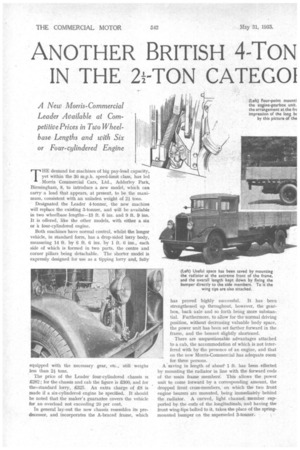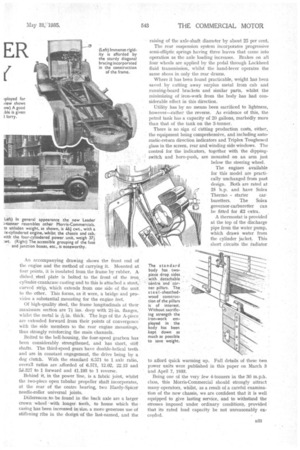ANOTHER BRITISH 4-TON ER IN THE 2I-TON CATEGOI
Page 50

Page 51

If you've noticed an error in this article please click here to report it so we can fix it.
A New Morris-Commercial Leader Available at Competitive Prices in Two Wheelbase Lengths and with Six or Four-cylindered Engine
THE demand for machines of big pay-load capacity, yet within the 30 m.p.h. speed-limit class, has led Morris Commercial Cars, Ltd., Adderley Park, Birmingham, 8, to introduce a new model, which can carry -a load that appears, at present, to be the maximum, consistent with an unladen weight of 2f tons.
Designated the Leader 4-tonner, the new machine will replace the existing 3-tonner, and will be available in two wheelbase lengths-13 ft. 6 ins. and 9 ft. 9 ins. It is offered, like the other models, with either a six or a four-cylindered engine.
Both machines have normal control, whilst the longer vehicle, in standard form, has a drop-sided lorry body, measuring 14 ft. by 6 ft. 6 ins. by 1 ft. 6 ins., each side of which is formed in two parts, the centre and corner pillars being detachable. The shorter model is expressly designed for use as a tipping lorry and, fully
equipped with the necessary gear, etc., still weighs .less than 2 tons.
The price of the Leader four-cylinclered chassis is £282; for the chassis and cab the figure is £300, and for thelstandard lorry, £325. An extra charge of £8 is made if a six-cylindered engine be specified. It should be noted that the maker's guarantee covers the vehicle for an overload not exceeding 20 per cent.
In general lay-out the new chassis resembles its predecessor, and incorporates the A-braced frame, which has proved highly successful. It has been strengthened up throughout, however, the gearbox, back axle and so forth being more substan-. tial. Furthermore, to allow for the normal driving position, without decreasing valuable body space, the power unit has been set farther forward in the frame, and the bonnet slightly shortened.
There are unquestionable advantages attached to a cab, the accommodation of which is not interfered with by the presence of an engine, and that on the new Morris-Commercial has adequate room for three persons.
A saving in length of about 1 ft. has been effected by mounting the radiator in line with the forward ends of the main frame members. This allows the power unit to come forward by a corresponding amount, the dropped front cross-members, on which the two front engine bearers are mounted, being immediately behind the radiator. A curved, light channel member supported by the ends of the longitudinals, and having the front wing-tips bolted to it, takes the place of the springmounted bumper on the superseded 3-ton.ner: An accompanying drawing shows the front end of the engine and the method of carrying it. Mounted at four points, it is insulated from the frame by rubber. A dished, steel plate is bolted to the front of the iron, cylinder-crankcase casting and to this is attached a stout, curved strip, which extends from one side of the unit to the other. This forms, as it were, a bridge and provides a substantial mounting for the engine feet.
Of high-quality steel, the frame longitudinals at their maximum section are 71 ins, deep with 21-in, flanges, whilst the metal is k in. thick. The legs of the A-piece. are extended forward from their points of convergence. with the side members to the rear engine mountings, • thus strongly reinforcing the main channels.
Bolted to the bell-housing, the four-speed gearbox has been considerably strengthened, and has short, stiff shafts. The third-speed gears have double-helical teeth and are in constant engagement, the drive being by a dog clutch. With the standard 8.571 to 1 axle ratio, overall ratios are afforded of 6.571, 12.02, 22.13 and 3.t.327 to 1 forward and 41.193 to 1 reverse.
Behind it, in the power line, is a fabric joint, whilst the two-piece open tubular propeller shaft incorporates, at the rear of the centre bearing, two •Hardy-Spicer needle-roller universal joints.
Differences to be found in the back axle are a larger crown wheel with longer, *teeth, to house which the casing has been increased in size, a more generous use of stiffening ribs in the design of the last-named, and the raising of the axle-shaft diameter by about 25 per cent.
The rear suspension system incorporates progressive semi-elliptic springs having three leaves that come into operation as the axle loading increases. Brakes on all four wheels are applied by the pedal through Lockheed fluid transmission, whilst the hand-lever operates the same shoes in only the rear drums.
Where it has been found practicable, weight has been saved by cutting away surplus metal from cab and running-board brackets and similar parts, whilst the minimizing of iron-work from the body has had considerable effect in this direction.
Utility has by no means been sacrificed to lightness, however—rather the reverse. As evidence of this, the petrol tank has a capacity of 20 gallons, markedly more than that of the tank on the 3-tanner.
There is no sign of cutting production costs, either, the equipment being comprehensive, and including automatic-return direction indicators and Triplex Toughened glass in the screen, rear and winding side windows. The control for the indicators, together with the dippingswitch and horn-push, are mounted on an arm just below the steering wheel.
The engines available for this model are practically unchanged from past design. Both are rated at 25 li.p. and have Solex Thermo starter car. buretters. The Solex governor-carburetter can be fitted for £2 extra. _ A thermostat is provided at the top of the discharge pipe from the water pump, which draws water from the cylinder jacket. This short circuits the radiator
to afford quick warming up. Full details of these two power units were published in this paper on March 3 and April 7, 1933.
Being one of the very few 4-tonners in the 30 m.p.h. class, this Morris-Commercial should strongly attract many operators, whilst, as a result of a careful examination of the new chassis, we are confident that it is well equipped to give lasting service, and to withstand the stresses imposed under ordinary conditions, provided that its rated load capacity be not unreasonably exceeded.




































































































